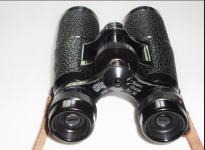Owlbarred
Well-known member

Trivia question: Name the brand of the binoculars she is holding.As Jane Goodall's...View attachment 1501361

Trivia question: Name the brand of the binoculars she is holding.As Jane Goodall's...View attachment 1501361
Old Zeiss (7x42)?Trivia question: Name the brand of the binoculars she is holding.

Still a major fault of Swarovski ...they have to understand their optics are used outside, frequently in places where they will be exposed to damp environments, hot environments, environments where users are likely to use insect repellents, etc, etcRichardD, post 2,
Your suggestion that the destruction of the cover might be caused by DEET or a compound comparable with DEET seems to me correct, I have seen terrible DEET victims in the past years. Fortunately Swarovski has a very able repair service. As a user you must be aware of the risk of this type of compounds.
Gijs van Ginkel

Many insect repellents are fine, but DEET is a well known plastic solvent - I don't think you can blame camera or binocular makers for damage caused by people using plastic solvents on their products.Still a major fault of Swarovski ...they have to understand their optics are used outside, frequently in places where they will be exposed to damp environments, hot environments, environments where users are likely to use insect repellents, etc, etc
Its like saying someone complaining that their umbrella is broken after using in the rain should be aware of the risk of using outside 🙂
Then why this problem only occurs in Swarovski binoculars? It is still a drawback that should be addressed by Swarovski. This problem is not only happened by DEET use. Wet, humid, tropical environmental conditions can cause this degradation too. Of course, anyone can buy binoculars from other brands if they want to use them in harsh environments 😀 However, it is pity to get a superb optics package with delicate exterior. BTW it seems, not like many of us the owner of this binoculars really used them. Definitely he is not a collector 😀Many insect repellents are fine, but DEET is a well known plastic solvent - I don't think you can blame camera or binocular makers for damage caused by people using plastic solvents on their products.

Then why this problem only occurs in Swarovski binoculars? It is still a drawback that should be addressed by Swarovski. This problem is not only happened by DEET use. Wet, humid, tropical environmental conditions can cause this degradation too. Of course, anyone can buy binoculars from other brands if they want to use them in harsh environments 😀 However, it is pity to get a superb optics package with delicate exterior. BTW it seems, not like many of us the owner of this binoculars really used them. Definitely he is not a collector 😀
Swarovski clearly mentioned that they use eco friendly, biodegradable material. So, it is not only DEET but also the extreme conditions in tropics. I have not seen this kind of extensive reports of armor degradation for binoculars from any other brand.It doesn't just occur with Swarovski, it's a problem with any make that uses plastic rather than rubber armour. Most photographers wouldn't touch DEET with a bargepole because of the way it damages kit. Water won't degrade plastic - I suspect again damage in tropical environments is likely down to an insect repellant containing DEET or similar compounds. The armour isn't particularly delicate if you don't use solvents, but Swarovski may well be looking at the formula, as obviously the rearmouring is a cost to them. I've no idea why the owner let them reach that point - Swarovski will rearmour them if they start showing damage.

Owlbarred, post 21
Seems to me Hensoldt Dialyt 8x30 (1948-1955) or 8x32 (produced from 1955).
Gijs van Ginkel
Good eye! I would have also guessed 7x42 due to the length of the binoculars, which would have served her well in the jungle, but when I saw your post, I took another look and the objectives do look smaller. Unusually long FL for an 8x30 especially these days when the trend is "smaller is better." AK prisms?


Agreed, this is not a Deet problem, it is a Swarovski problem. Very disappointing.Still a major fault of Swarovski ...they have to understand their optics are used outside, frequently in places where they will be exposed to damp environments, hot environments, environments where users are likely to use insect repellents, etc, etc
Its like saying someone complaining that their umbrella is broken after using in the rain should be aware of the risk of using outside 🙂
1948-1963 | Dialyt | 8 x 32 | FOV 150yd/1000yd = 8 deg.36'. 570 gm. Price $157.(1961) Sold after 1955Jane Goodall
Hensoldt Dialyt 8x32

1948-1963 | Dialyt | 8 x 32 | FOV 150yd/1000yd = 8 deg.36'. 570 gm. Price $157.(1961) Sold after 1955
Apparently, she still prefers long binoculars.Jane Goodall
Hensoldt Dialyt 8x32
______
Jane Goodall
Swarovski EL 8.5x42 or 10x42 ( foto 2017)
